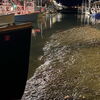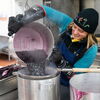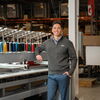Fish farming heads for deeper waters
SEARSMONT — A submersible cage for cultivating fish made by Ocean Farm Technologies here is drawing interest from technology sectors, as its developer eyes the increasing potential of off-shore fish farming.
Steve Page, founder and CEO of Ocean Farm, said submersible cages will enable fish farmers to avoid complications associated with near-shore pens, such as damage to the seafloor and complaints from shoreline landowners.
His company created AquaPod, a 64-foot diameter, 3,600-cubic-meter cage made of polyethylene and wire mesh that can contain up to 25,000 fish. Sold since 2007, the cages already are used by fish farms in Puerto Rico, Panama, South Korea and Mexico. The cages are designed to be moored at a stationary, licensed site at depths around 100 feet below sea level.
Now a technology company in Massachusetts is looking at designing a wave-based power system to run functions like the AquaPod’s automatic feeding mechanism, which would allow it to operate farther from shore. Earlier this month, Resolute Marine Energy of Watertown, Mass., ran the first test of a wave power system that uses a buoy attached to an underwater platform. The device creates a pumping action that can convert wave power into compressed air energy.
Other researchers are looking at ways to get an AquaPod to an offshore site.
Massachusetts Institute of Technology researchers helped develop a propulsion system — twin, 8-foot, 6.2-horsepower propellers that churn through the water like big screws. The propulsion system was demonstrated on an AquaPod last year at Snapperfarm Inc. fish farm in Puerto Rico.
Page said offshore aquaculture could help to stabilize fish stocks. “Aquaculture will contribute to the sustainability of fish populations by supplying healthy seafood while reducing pressure on wild stocks, eliminating waste from by-catch, and minimizing the amount of protein needed to grow fish through careful management of resources,” he said. Fin fish require 1.1 pounds of feed per pound of flesh, a ratio that is at least twice as efficient as feed conversion ratios for many livestock, Page said. For example, it generally takes 6 pounds of feed to produce 1 pound of beef.
The U.S. Congress is reviewing legislation to give the U.S. Department of Commerce authority to set regulations for aquaculture three to 200 miles offshore, opening up federal waters to fish farming.
Jim Kozubek









Comments